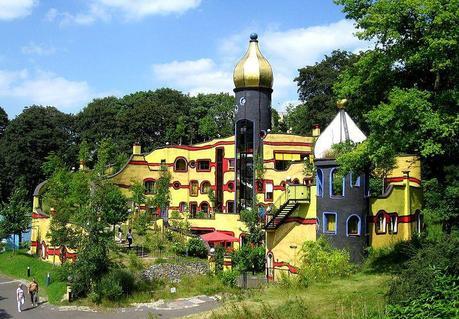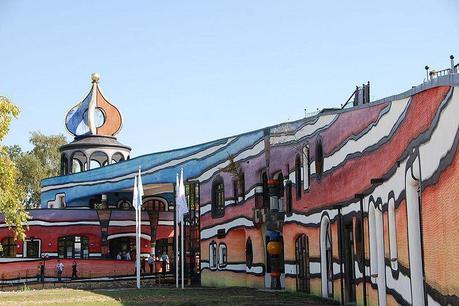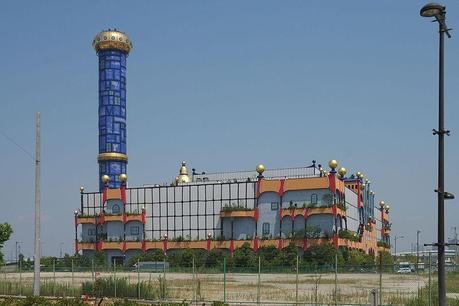 SPECIAL FEATURE ON F. HUNDERTWASSER [Gallery]
SPECIAL FEATURE ON F. HUNDERTWASSER [Gallery]
I first came across the great Austrian painter and architect Friedensreich Hundertwasser [1928-2000] during research for the August 17th article on Kuchlbauer's Bierwelt. A look at his body of work immediately placed him with Frank O. Gehry in the category of architects who have made major contributions to the stranger end of the architectural spectrum. Like Gehry multiple ...
To be honest unlike his architectural style which I think is magnificent I have to say his paintings are not to my personal taste. However you can see in the work the roots of his architectural style, the profusion of bright and vibrant colors, the eschewing of straight lines and the predominance of irregular shapes and forms. He was not averse to putting his style into words and he left us many quotes that seem to not only sum up his architectural style but also speak to his character and broader outlook on life. Among the best known quotes are the following:
• "When we dream alone it is only a dream, but when many dream together it is the beginning of a new reality."
• "The straight line leads to the downfall of humanity."
• "If man walks in nature's midst, then he is nature's guest and must learn to behave as a well-brought-up guest."
This aspect of his style is best summed up with another couple of his quotations; in this case they our favorites and without doubt they are quotes that also provide insight into his philosophy on life and spirituality:
"I’ve worked a great deal with grass roofs, putting soil on top and having things grow, but there is something strange in this, more than ecological. It is a religious act to have soil on your roof and trees growing on top of you; the act reconciles you with God, with nature, maybe not Christian or Jewish monotheism, but something wider, older - a very ancient wisdom."
and again:
"The true proportions in this world are the views to the stars and the views down to the surface of the earth. Grass and vegetation in the city should grow on all horizontal spaces - that is to say, wherever rain and snow falls vegetation should grow, on the roads and on the roofs. The horizontal is the domain of nature and wherever vegetation grows on the horizontal level man is off limits; he should not interfere. I mean taking away territories from nature, which human beings have always done."
In addition to his use of color and avoidance of straight lines which are common to all of his projects many also include another common element; the "crowning" of his creations with cupolas or "onion domes". The two Ronald McDonald Houses designed by Hundertwasser demonstrate this and are shown below. They are located in Essen, Germany and Valkenburg, Netherlands.


During the course of his career Hundertwasser did not appear to ever restrict himself to any one type of project or even show any leaning to a particular type of building; a characteristic that most architects do seem to have. In fact the range of projects he embraced was very broad and extends from hotels and apartment complexes to residences and business premises and on to industrial plants and even public toilets. He managed to infuse all of his projects with his trademarks of color, vibrancy and fun even when the subject of his design was decidedly unglamorous; take for example the two plants he designed in Osaka, Japan the Maishima Incineration Plant and the Maishima Sludge Center.


All in all Hundertwasser's legacy is one of vibrant projects alive with color, spirals and curves. If you have any interest at all in the stranger, and in my opinion cooler, end of the world of architecture say a big thank you to Friedensreich Hundertwasser because he certainly made a big contribution.
Check out the gallery here. All images used in this article and in the gallery are from Wikipedia.
<a href="http://ws.amazon.com/widgets/q?rt=tf_ssw&ServiceVersion=20070822&MarketPlace=US&ID=V20070822%2FUS%2Fthgrolli-20%2F8003%2Fc532591b-4465-4434-b264-984b4b1f45cd&Operation=NoScript">Amazon.com Widgets</a>

